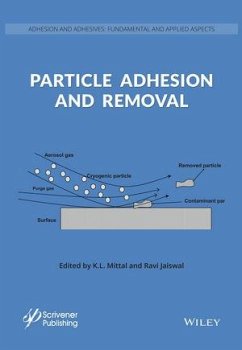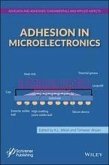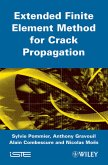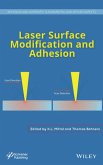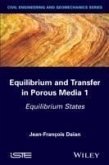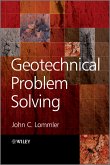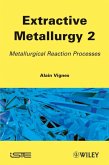177,99 €
177,99 €
inkl. MwSt.
Sofort per Download lieferbar

0 °P sammeln
177,99 €
Als Download kaufen

177,99 €
inkl. MwSt.
Sofort per Download lieferbar

0 °P sammeln
Jetzt verschenken
Alle Infos zum eBook verschenken
177,99 €
inkl. MwSt.
Sofort per Download lieferbar
Alle Infos zum eBook verschenken

0 °P sammeln
- Format: PDF
- Merkliste
- Auf die Merkliste
- Bewerten Bewerten
- Teilen
- Produkt teilen
- Produkterinnerung
- Produkterinnerung

Bitte loggen Sie sich zunächst in Ihr Kundenkonto ein oder registrieren Sie sich bei
bücher.de, um das eBook-Abo tolino select nutzen zu können.
Hier können Sie sich einloggen
Hier können Sie sich einloggen
Sie sind bereits eingeloggt. Klicken Sie auf 2. tolino select Abo, um fortzufahren.

Bitte loggen Sie sich zunächst in Ihr Kundenkonto ein oder registrieren Sie sich bei bücher.de, um das eBook-Abo tolino select nutzen zu können.
The book provides a comprehensive and easily accessible reference source covering all important aspects of particle adhesion and removal. The core objective is to cover both fundamental and applied aspects of particle adhesion and removal with emphasis on recent developments.
Among the topics to be covered include:
1. Fundamentals of surface forces in particle adhesion and removal. 2. Mechanisms of particle adhesion and removal. 3. Experimental methods (e.g. AFM, SFA,SFM,IFM, etc.) to understand particle-particle and particle-substrate interactions. 4. Mechanics of adhesion of micro-…mehr
- Geräte: PC
- ohne Kopierschutz
- eBook Hilfe
Andere Kunden interessierten sich auch für
![Adhesion in Microelectronics (eBook, PDF) Adhesion in Microelectronics (eBook, PDF)]() K. L. MittalAdhesion in Microelectronics (eBook, PDF)177,99 €
K. L. MittalAdhesion in Microelectronics (eBook, PDF)177,99 €![Extended Finite Element Method for Crack Propagation (eBook, PDF) Extended Finite Element Method for Crack Propagation (eBook, PDF)]() Sylvie PommierExtended Finite Element Method for Crack Propagation (eBook, PDF)139,99 €
Sylvie PommierExtended Finite Element Method for Crack Propagation (eBook, PDF)139,99 €![Laser Surface Modification and Adhesion (eBook, PDF) Laser Surface Modification and Adhesion (eBook, PDF)]() K. L. MittalLaser Surface Modification and Adhesion (eBook, PDF)177,99 €
K. L. MittalLaser Surface Modification and Adhesion (eBook, PDF)177,99 €![Equilibrium and Transfer in Porous Media 1 (eBook, PDF) Equilibrium and Transfer in Porous Media 1 (eBook, PDF)]() Jean-François DaianEquilibrium and Transfer in Porous Media 1 (eBook, PDF)139,99 €
Jean-François DaianEquilibrium and Transfer in Porous Media 1 (eBook, PDF)139,99 €![Geotechnical Problem Solving (eBook, PDF) Geotechnical Problem Solving (eBook, PDF)]() John C. LommlerGeotechnical Problem Solving (eBook, PDF)112,99 €
John C. LommlerGeotechnical Problem Solving (eBook, PDF)112,99 €![Extractive Metallurgy 2 (eBook, PDF) Extractive Metallurgy 2 (eBook, PDF)]() Alain VignesExtractive Metallurgy 2 (eBook, PDF)149,99 €
Alain VignesExtractive Metallurgy 2 (eBook, PDF)149,99 €![Microwaves and Metals (eBook, PDF) Microwaves and Metals (eBook, PDF)]() Manoj GuptaMicrowaves and Metals (eBook, PDF)101,99 €
Manoj GuptaMicrowaves and Metals (eBook, PDF)101,99 €-
-
-
The book provides a comprehensive and easily accessible reference source covering all important aspects of particle adhesion and removal. The core objective is to cover both fundamental and applied aspects of particle adhesion and removal with emphasis on recent developments.
Among the topics to be covered include:
1. Fundamentals of surface forces in particle adhesion and removal. 2. Mechanisms of particle adhesion and removal. 3. Experimental methods (e.g. AFM, SFA,SFM,IFM, etc.) to understand particle-particle and particle-substrate interactions. 4. Mechanics of adhesion of micro- and nanoscale particles. 5. Various factors affecting particle adhesion to a variety of substrates. 6. Surface modification techniques to modulate particle adhesion. 7. Various cleaning methods (both wet & dry) for particle removal. 8. Relevance of particle adhesion in a host of technologies ranging from simple to ultra-sophisticated.
Among the topics to be covered include:
1. Fundamentals of surface forces in particle adhesion and removal. 2. Mechanisms of particle adhesion and removal. 3. Experimental methods (e.g. AFM, SFA,SFM,IFM, etc.) to understand particle-particle and particle-substrate interactions. 4. Mechanics of adhesion of micro- and nanoscale particles. 5. Various factors affecting particle adhesion to a variety of substrates. 6. Surface modification techniques to modulate particle adhesion. 7. Various cleaning methods (both wet & dry) for particle removal. 8. Relevance of particle adhesion in a host of technologies ranging from simple to ultra-sophisticated.
Dieser Download kann aus rechtlichen Gründen nur mit Rechnungsadresse in D ausgeliefert werden.
Produktdetails
- Produktdetails
- Verlag: Wiley-IEEE Press
- Erscheinungstermin: 2. Februar 2015
- Englisch
- ISBN-13: 9781118831557
- Artikelnr.: 42292478
- Verlag: Wiley-IEEE Press
- Erscheinungstermin: 2. Februar 2015
- Englisch
- ISBN-13: 9781118831557
- Artikelnr.: 42292478
- Herstellerkennzeichnung Die Herstellerinformationen sind derzeit nicht verfügbar.
Kashmiri Lal Mittal was employed by the IBM Corporation from 1972 through 1993. Currently, he is teaching and consulting worldwide in the broad areas of adhesion as well as surface cleaning. He has received numerous awards and honors including the title of doctor honoris causa from Maria Curie-SkBodowska University, Lublin, Poland. He is the editor of more than 115 books dealing with adhesion measurement, adhesion of polymeric coatings, polymer surfaces, adhesive joints, adhesion promoters, thin films, polyimides, surface modification, surface cleaning, and surfactants. Dr. Mittal is also the Founding Editor of the journal Reviews of Adhesion and Adhesives.
Ravi Jaiswal is a chemical engineer and an active researcher in the field of surface and interfacial science. He has authored more than 10 original research publications in the field of particle adhesion and removal. He has delivered more than 10 technical talks in the national and international conferences covering topics relevant to particle adhesion. He is a regular reviewer of the research manuscripts published in the journal of IEEE Transactions on Semiconductor Manufacturing. He has been awarded 'Leighton H. Peebles Award' by The Adhesion Society in 2009 in the recognition to his outstanding graduate research contribution in the field of adhesion science and technology. Ravi completed his bachelor degree in chemical engineering from Indian Institute of Technology (IIT) Kanpur, India in 2004. He graduated with PhD in chemical engineering from Purdue University, W. Lafayette, IN, USA in 2008. He is currently employed at Sun Edison (formerly MEMC Electronic Materials), St. Peters, MO as a research scientist.
Ravi Jaiswal is a chemical engineer and an active researcher in the field of surface and interfacial science. He has authored more than 10 original research publications in the field of particle adhesion and removal. He has delivered more than 10 technical talks in the national and international conferences covering topics relevant to particle adhesion. He is a regular reviewer of the research manuscripts published in the journal of IEEE Transactions on Semiconductor Manufacturing. He has been awarded 'Leighton H. Peebles Award' by The Adhesion Society in 2009 in the recognition to his outstanding graduate research contribution in the field of adhesion science and technology. Ravi completed his bachelor degree in chemical engineering from Indian Institute of Technology (IIT) Kanpur, India in 2004. He graduated with PhD in chemical engineering from Purdue University, W. Lafayette, IN, USA in 2008. He is currently employed at Sun Edison (formerly MEMC Electronic Materials), St. Peters, MO as a research scientist.
Preface xv
Part 1: Particle Adhesion: Fundamentals 1
1 Fundamental Forces in Particle Adhesion 3
Stephen Beaudoin, Priyanka Jaiswal, Aaron Harrison, Jennifer Laster,
Kathryn Smith, Melissa Sweat, and Myles Thomas
1.1 Introduction 3
1.2 Various Forces in Particle Adhesion 4
1.3 Summary 69
References 70
2 Mechanics of Particle Adhesion and Removal 81
Goodarz Ahmadi
2.1 Introduction 81
2.2 Models 83
2.3 Simulations Results 96
2.4 Summary and Conclusions 99
Acknowledgements 100
References 100
3 Microscopic Particle Contact Adhesion Models and Macroscopic Behavior of
Surface Modified Particles 105
Katja Mader-Arndt, Zinaida Kutelova, and Jürgen Tomas
3.1 Introduction 105
3.2 Constitutive Contact Models 107
3.3 Macroscopic Powder Behavior - Continuum Mechanics Approach 121
3.4 Surface Modification to Alter the Adhesion Properties 124
3.5 Experimental Measurements of the Adhesion Forces 130
3.6 Summary and Conclusions 146
Acknowledgements 147
List of Symbols 147
References 148
4 Characterization of Single Particle Adhesion: A Review of Recent Progress
157
Armin Saeedi Vahdat and Cetin Cetinkaya
4.1 Introduction 157
4.2 Background 159
4.3 Recent Developments 167
4.4 Conclusions and Remarks 193
Acknowledgments 194
List of Symbols 194
References 196
Part 2: Particle Removal Techniques 201
5 High Intensity Ultrasonic Cleaning for Particle Removal 203
Sami B. Awad and Nadia F. Awad
5.1 Introduction 204
5.2 Ultrasound and Ultrasonics 204
5.3 Cavitation Phenomenon 207
5.4 Generation of Ultrasound - Transducers 211
5.5 Ultrasonic Generators 217
5.6 Principles of Ultrasonic Cleaning for Particle Removal 219
5.7 Determination of Residual Particles on Surfaces 223
5.8 Ultrasonic Aqueous Cleaning Equipment and Process 225
5.9 Precision Cleaning 228
5.10 Contaminants 228
5.11 Ultrasonic Cavitation Forces and Surface Cleaning 230
5.12 Cleaning Chemistry 232
5.13 Mechanism of Cleaning 236
5.14 Cavitation Erosion 238
5.15 Summary 239
References 239
6 Megasonic Cleaning for Particle Removal 243
Manish Keswani, Rajesh Balachandran, and Pierre Deymier
6.1 Introduction 243
6.2 Principles of Megasonic Cleaning 247
6.3 Particle Removal Mechanisms During Megasonic Cleaning 259
6.4 Types of Megasonic Systems 262
6.5 Particle Removal and Feature Damage in Megasonic Cleaning 264
6.6 Summary 274
References 274
7 High Speed Air Jet Removal of Particles from Solid Surfaces 281
Kuniaki Gotoh
7.1 Introduction 281
7.2 Fundamental Characteristics of the Air Jet 282
7.3 Fundamentals of Air Jet Particle Removal 286
7.4 New Methods Using Air Jet 300
7.5 Summary and Prospect 307
List of Symbols 308
References 309
8 Droplet Spray Technique for Particle Removal 313
James T. Snow, Masanobu Sato, and Takayoshi Tanaka
8.1 Introduction 313
8.2 Droplet Impact Phenomena 314
8.3 Cleaning Process Window 318
8.4 Droplet Spray Technique for Semiconductor Wafer Cleaning 324
8.5 Summary 331
References 331
9. Laser-Induced High-Pressure Micro-Spray Process for Nanoscale Particle
Removal 337
Daehwan Ahn, Changho Seo, and Dongsik Kim
9.1 Introduction 337
9.2 Concept of Droplet Opto-Hydrodynamic Cleaning (DOC) 340
9.3 Micro-Spray Generation by LIB 343
9.4 Mechanisms of Particle Removal by Laser-Induced Spray Jet 344
9.5 Generation of Micro-Spray Jet 345
9.6 Nanoscale Particle Removal 352
9.7 Summary 360
References 360
10 Wiper-Based Cleaning of Particles from Surfaces 365
Brad Lyon and Jay Postlewaite
10.1 Introduction 366
10.2 Basic Mechanism of Wiping for Cleaning of Particles and Other
Contaminants 371
10.3 Various Types of Wipers 379
10.4 Proper Ways to Carry Out Wiping or How to Use Wipers Properly 390
10.5 Characterization of Wipers 396
10.6 Results Obtained Using Wiping 398
10.7 Future Directions 405
10.8 Summary 406
References 408
11 Application of Strippable Coatings for Removal of Particulate
Contaminants 411
Rajiv Kohli
11.1 Introduction 411
11.2 Coating Description 412
11.3 Types of Strippable Coatings 413
11.4 Issues with Strippable Coatings 426
11.5 Precision Cleaning Applications 427
11.6 Summary 443
Disclaimer 443
References 443
12 Cryoaerosol Cleaning of Particles from Surfaces 453
Souvik Banerjee
12.1 Introduction 453
12.2 History of Cryoaerosol Cleaning 455
12.3 Thermodynamics of Cryoaerosol Processes 456
12.4 Cleaning Mechanism 461
12.5 Factors Affecting Cleaning Performance 462
12.6 Results Obtained by Cryoaerosol Cleaning 469
12.7 Summary and Prospects 473
References 474
13 Supercritical Carbon Dioxide Cleaning: Relevance to Particle Removal 477
Rajiv Kohli
13.1 Introduction 477
13.2 Surface Cleanliness Levels 478
13.3 Dense Phase Fluids 479
13.4 Principles of Supercritical CO2 Cleaning 489
13.5 Advantages and Disadvantages of Supercritical CO2 Cleaning 493
13.6 Applications 496
13.7 Summary and Conclusions 502
Acknowledgement 503
Disclaimer 503
References 503
14 The Use of Surfactants to Enhance Particle Removal from Surfaces 519
Brian Grady
14.1 Introduction 519
14.2 Solid-Solid Interactions 520
14.3 Introduction to Surfactants 524
14.4 Surfactant Adsorption at Solid Surfaces 529
14.5 Surfactants and Particulate Removal 535
14.6 Prospects 539
14.7 Summary 540
Acknowledgements 540
References 540
Index 543
Part 1: Particle Adhesion: Fundamentals 1
1 Fundamental Forces in Particle Adhesion 3
Stephen Beaudoin, Priyanka Jaiswal, Aaron Harrison, Jennifer Laster,
Kathryn Smith, Melissa Sweat, and Myles Thomas
1.1 Introduction 3
1.2 Various Forces in Particle Adhesion 4
1.3 Summary 69
References 70
2 Mechanics of Particle Adhesion and Removal 81
Goodarz Ahmadi
2.1 Introduction 81
2.2 Models 83
2.3 Simulations Results 96
2.4 Summary and Conclusions 99
Acknowledgements 100
References 100
3 Microscopic Particle Contact Adhesion Models and Macroscopic Behavior of
Surface Modified Particles 105
Katja Mader-Arndt, Zinaida Kutelova, and Jürgen Tomas
3.1 Introduction 105
3.2 Constitutive Contact Models 107
3.3 Macroscopic Powder Behavior - Continuum Mechanics Approach 121
3.4 Surface Modification to Alter the Adhesion Properties 124
3.5 Experimental Measurements of the Adhesion Forces 130
3.6 Summary and Conclusions 146
Acknowledgements 147
List of Symbols 147
References 148
4 Characterization of Single Particle Adhesion: A Review of Recent Progress
157
Armin Saeedi Vahdat and Cetin Cetinkaya
4.1 Introduction 157
4.2 Background 159
4.3 Recent Developments 167
4.4 Conclusions and Remarks 193
Acknowledgments 194
List of Symbols 194
References 196
Part 2: Particle Removal Techniques 201
5 High Intensity Ultrasonic Cleaning for Particle Removal 203
Sami B. Awad and Nadia F. Awad
5.1 Introduction 204
5.2 Ultrasound and Ultrasonics 204
5.3 Cavitation Phenomenon 207
5.4 Generation of Ultrasound - Transducers 211
5.5 Ultrasonic Generators 217
5.6 Principles of Ultrasonic Cleaning for Particle Removal 219
5.7 Determination of Residual Particles on Surfaces 223
5.8 Ultrasonic Aqueous Cleaning Equipment and Process 225
5.9 Precision Cleaning 228
5.10 Contaminants 228
5.11 Ultrasonic Cavitation Forces and Surface Cleaning 230
5.12 Cleaning Chemistry 232
5.13 Mechanism of Cleaning 236
5.14 Cavitation Erosion 238
5.15 Summary 239
References 239
6 Megasonic Cleaning for Particle Removal 243
Manish Keswani, Rajesh Balachandran, and Pierre Deymier
6.1 Introduction 243
6.2 Principles of Megasonic Cleaning 247
6.3 Particle Removal Mechanisms During Megasonic Cleaning 259
6.4 Types of Megasonic Systems 262
6.5 Particle Removal and Feature Damage in Megasonic Cleaning 264
6.6 Summary 274
References 274
7 High Speed Air Jet Removal of Particles from Solid Surfaces 281
Kuniaki Gotoh
7.1 Introduction 281
7.2 Fundamental Characteristics of the Air Jet 282
7.3 Fundamentals of Air Jet Particle Removal 286
7.4 New Methods Using Air Jet 300
7.5 Summary and Prospect 307
List of Symbols 308
References 309
8 Droplet Spray Technique for Particle Removal 313
James T. Snow, Masanobu Sato, and Takayoshi Tanaka
8.1 Introduction 313
8.2 Droplet Impact Phenomena 314
8.3 Cleaning Process Window 318
8.4 Droplet Spray Technique for Semiconductor Wafer Cleaning 324
8.5 Summary 331
References 331
9. Laser-Induced High-Pressure Micro-Spray Process for Nanoscale Particle
Removal 337
Daehwan Ahn, Changho Seo, and Dongsik Kim
9.1 Introduction 337
9.2 Concept of Droplet Opto-Hydrodynamic Cleaning (DOC) 340
9.3 Micro-Spray Generation by LIB 343
9.4 Mechanisms of Particle Removal by Laser-Induced Spray Jet 344
9.5 Generation of Micro-Spray Jet 345
9.6 Nanoscale Particle Removal 352
9.7 Summary 360
References 360
10 Wiper-Based Cleaning of Particles from Surfaces 365
Brad Lyon and Jay Postlewaite
10.1 Introduction 366
10.2 Basic Mechanism of Wiping for Cleaning of Particles and Other
Contaminants 371
10.3 Various Types of Wipers 379
10.4 Proper Ways to Carry Out Wiping or How to Use Wipers Properly 390
10.5 Characterization of Wipers 396
10.6 Results Obtained Using Wiping 398
10.7 Future Directions 405
10.8 Summary 406
References 408
11 Application of Strippable Coatings for Removal of Particulate
Contaminants 411
Rajiv Kohli
11.1 Introduction 411
11.2 Coating Description 412
11.3 Types of Strippable Coatings 413
11.4 Issues with Strippable Coatings 426
11.5 Precision Cleaning Applications 427
11.6 Summary 443
Disclaimer 443
References 443
12 Cryoaerosol Cleaning of Particles from Surfaces 453
Souvik Banerjee
12.1 Introduction 453
12.2 History of Cryoaerosol Cleaning 455
12.3 Thermodynamics of Cryoaerosol Processes 456
12.4 Cleaning Mechanism 461
12.5 Factors Affecting Cleaning Performance 462
12.6 Results Obtained by Cryoaerosol Cleaning 469
12.7 Summary and Prospects 473
References 474
13 Supercritical Carbon Dioxide Cleaning: Relevance to Particle Removal 477
Rajiv Kohli
13.1 Introduction 477
13.2 Surface Cleanliness Levels 478
13.3 Dense Phase Fluids 479
13.4 Principles of Supercritical CO2 Cleaning 489
13.5 Advantages and Disadvantages of Supercritical CO2 Cleaning 493
13.6 Applications 496
13.7 Summary and Conclusions 502
Acknowledgement 503
Disclaimer 503
References 503
14 The Use of Surfactants to Enhance Particle Removal from Surfaces 519
Brian Grady
14.1 Introduction 519
14.2 Solid-Solid Interactions 520
14.3 Introduction to Surfactants 524
14.4 Surfactant Adsorption at Solid Surfaces 529
14.5 Surfactants and Particulate Removal 535
14.6 Prospects 539
14.7 Summary 540
Acknowledgements 540
References 540
Index 543
Preface xv
Part 1: Particle Adhesion: Fundamentals 1
1 Fundamental Forces in Particle Adhesion 3
Stephen Beaudoin, Priyanka Jaiswal, Aaron Harrison, Jennifer Laster,
Kathryn Smith, Melissa Sweat, and Myles Thomas
1.1 Introduction 3
1.2 Various Forces in Particle Adhesion 4
1.3 Summary 69
References 70
2 Mechanics of Particle Adhesion and Removal 81
Goodarz Ahmadi
2.1 Introduction 81
2.2 Models 83
2.3 Simulations Results 96
2.4 Summary and Conclusions 99
Acknowledgements 100
References 100
3 Microscopic Particle Contact Adhesion Models and Macroscopic Behavior of
Surface Modified Particles 105
Katja Mader-Arndt, Zinaida Kutelova, and Jürgen Tomas
3.1 Introduction 105
3.2 Constitutive Contact Models 107
3.3 Macroscopic Powder Behavior - Continuum Mechanics Approach 121
3.4 Surface Modification to Alter the Adhesion Properties 124
3.5 Experimental Measurements of the Adhesion Forces 130
3.6 Summary and Conclusions 146
Acknowledgements 147
List of Symbols 147
References 148
4 Characterization of Single Particle Adhesion: A Review of Recent Progress
157
Armin Saeedi Vahdat and Cetin Cetinkaya
4.1 Introduction 157
4.2 Background 159
4.3 Recent Developments 167
4.4 Conclusions and Remarks 193
Acknowledgments 194
List of Symbols 194
References 196
Part 2: Particle Removal Techniques 201
5 High Intensity Ultrasonic Cleaning for Particle Removal 203
Sami B. Awad and Nadia F. Awad
5.1 Introduction 204
5.2 Ultrasound and Ultrasonics 204
5.3 Cavitation Phenomenon 207
5.4 Generation of Ultrasound - Transducers 211
5.5 Ultrasonic Generators 217
5.6 Principles of Ultrasonic Cleaning for Particle Removal 219
5.7 Determination of Residual Particles on Surfaces 223
5.8 Ultrasonic Aqueous Cleaning Equipment and Process 225
5.9 Precision Cleaning 228
5.10 Contaminants 228
5.11 Ultrasonic Cavitation Forces and Surface Cleaning 230
5.12 Cleaning Chemistry 232
5.13 Mechanism of Cleaning 236
5.14 Cavitation Erosion 238
5.15 Summary 239
References 239
6 Megasonic Cleaning for Particle Removal 243
Manish Keswani, Rajesh Balachandran, and Pierre Deymier
6.1 Introduction 243
6.2 Principles of Megasonic Cleaning 247
6.3 Particle Removal Mechanisms During Megasonic Cleaning 259
6.4 Types of Megasonic Systems 262
6.5 Particle Removal and Feature Damage in Megasonic Cleaning 264
6.6 Summary 274
References 274
7 High Speed Air Jet Removal of Particles from Solid Surfaces 281
Kuniaki Gotoh
7.1 Introduction 281
7.2 Fundamental Characteristics of the Air Jet 282
7.3 Fundamentals of Air Jet Particle Removal 286
7.4 New Methods Using Air Jet 300
7.5 Summary and Prospect 307
List of Symbols 308
References 309
8 Droplet Spray Technique for Particle Removal 313
James T. Snow, Masanobu Sato, and Takayoshi Tanaka
8.1 Introduction 313
8.2 Droplet Impact Phenomena 314
8.3 Cleaning Process Window 318
8.4 Droplet Spray Technique for Semiconductor Wafer Cleaning 324
8.5 Summary 331
References 331
9. Laser-Induced High-Pressure Micro-Spray Process for Nanoscale Particle
Removal 337
Daehwan Ahn, Changho Seo, and Dongsik Kim
9.1 Introduction 337
9.2 Concept of Droplet Opto-Hydrodynamic Cleaning (DOC) 340
9.3 Micro-Spray Generation by LIB 343
9.4 Mechanisms of Particle Removal by Laser-Induced Spray Jet 344
9.5 Generation of Micro-Spray Jet 345
9.6 Nanoscale Particle Removal 352
9.7 Summary 360
References 360
10 Wiper-Based Cleaning of Particles from Surfaces 365
Brad Lyon and Jay Postlewaite
10.1 Introduction 366
10.2 Basic Mechanism of Wiping for Cleaning of Particles and Other
Contaminants 371
10.3 Various Types of Wipers 379
10.4 Proper Ways to Carry Out Wiping or How to Use Wipers Properly 390
10.5 Characterization of Wipers 396
10.6 Results Obtained Using Wiping 398
10.7 Future Directions 405
10.8 Summary 406
References 408
11 Application of Strippable Coatings for Removal of Particulate
Contaminants 411
Rajiv Kohli
11.1 Introduction 411
11.2 Coating Description 412
11.3 Types of Strippable Coatings 413
11.4 Issues with Strippable Coatings 426
11.5 Precision Cleaning Applications 427
11.6 Summary 443
Disclaimer 443
References 443
12 Cryoaerosol Cleaning of Particles from Surfaces 453
Souvik Banerjee
12.1 Introduction 453
12.2 History of Cryoaerosol Cleaning 455
12.3 Thermodynamics of Cryoaerosol Processes 456
12.4 Cleaning Mechanism 461
12.5 Factors Affecting Cleaning Performance 462
12.6 Results Obtained by Cryoaerosol Cleaning 469
12.7 Summary and Prospects 473
References 474
13 Supercritical Carbon Dioxide Cleaning: Relevance to Particle Removal 477
Rajiv Kohli
13.1 Introduction 477
13.2 Surface Cleanliness Levels 478
13.3 Dense Phase Fluids 479
13.4 Principles of Supercritical CO2 Cleaning 489
13.5 Advantages and Disadvantages of Supercritical CO2 Cleaning 493
13.6 Applications 496
13.7 Summary and Conclusions 502
Acknowledgement 503
Disclaimer 503
References 503
14 The Use of Surfactants to Enhance Particle Removal from Surfaces 519
Brian Grady
14.1 Introduction 519
14.2 Solid-Solid Interactions 520
14.3 Introduction to Surfactants 524
14.4 Surfactant Adsorption at Solid Surfaces 529
14.5 Surfactants and Particulate Removal 535
14.6 Prospects 539
14.7 Summary 540
Acknowledgements 540
References 540
Index 543
Part 1: Particle Adhesion: Fundamentals 1
1 Fundamental Forces in Particle Adhesion 3
Stephen Beaudoin, Priyanka Jaiswal, Aaron Harrison, Jennifer Laster,
Kathryn Smith, Melissa Sweat, and Myles Thomas
1.1 Introduction 3
1.2 Various Forces in Particle Adhesion 4
1.3 Summary 69
References 70
2 Mechanics of Particle Adhesion and Removal 81
Goodarz Ahmadi
2.1 Introduction 81
2.2 Models 83
2.3 Simulations Results 96
2.4 Summary and Conclusions 99
Acknowledgements 100
References 100
3 Microscopic Particle Contact Adhesion Models and Macroscopic Behavior of
Surface Modified Particles 105
Katja Mader-Arndt, Zinaida Kutelova, and Jürgen Tomas
3.1 Introduction 105
3.2 Constitutive Contact Models 107
3.3 Macroscopic Powder Behavior - Continuum Mechanics Approach 121
3.4 Surface Modification to Alter the Adhesion Properties 124
3.5 Experimental Measurements of the Adhesion Forces 130
3.6 Summary and Conclusions 146
Acknowledgements 147
List of Symbols 147
References 148
4 Characterization of Single Particle Adhesion: A Review of Recent Progress
157
Armin Saeedi Vahdat and Cetin Cetinkaya
4.1 Introduction 157
4.2 Background 159
4.3 Recent Developments 167
4.4 Conclusions and Remarks 193
Acknowledgments 194
List of Symbols 194
References 196
Part 2: Particle Removal Techniques 201
5 High Intensity Ultrasonic Cleaning for Particle Removal 203
Sami B. Awad and Nadia F. Awad
5.1 Introduction 204
5.2 Ultrasound and Ultrasonics 204
5.3 Cavitation Phenomenon 207
5.4 Generation of Ultrasound - Transducers 211
5.5 Ultrasonic Generators 217
5.6 Principles of Ultrasonic Cleaning for Particle Removal 219
5.7 Determination of Residual Particles on Surfaces 223
5.8 Ultrasonic Aqueous Cleaning Equipment and Process 225
5.9 Precision Cleaning 228
5.10 Contaminants 228
5.11 Ultrasonic Cavitation Forces and Surface Cleaning 230
5.12 Cleaning Chemistry 232
5.13 Mechanism of Cleaning 236
5.14 Cavitation Erosion 238
5.15 Summary 239
References 239
6 Megasonic Cleaning for Particle Removal 243
Manish Keswani, Rajesh Balachandran, and Pierre Deymier
6.1 Introduction 243
6.2 Principles of Megasonic Cleaning 247
6.3 Particle Removal Mechanisms During Megasonic Cleaning 259
6.4 Types of Megasonic Systems 262
6.5 Particle Removal and Feature Damage in Megasonic Cleaning 264
6.6 Summary 274
References 274
7 High Speed Air Jet Removal of Particles from Solid Surfaces 281
Kuniaki Gotoh
7.1 Introduction 281
7.2 Fundamental Characteristics of the Air Jet 282
7.3 Fundamentals of Air Jet Particle Removal 286
7.4 New Methods Using Air Jet 300
7.5 Summary and Prospect 307
List of Symbols 308
References 309
8 Droplet Spray Technique for Particle Removal 313
James T. Snow, Masanobu Sato, and Takayoshi Tanaka
8.1 Introduction 313
8.2 Droplet Impact Phenomena 314
8.3 Cleaning Process Window 318
8.4 Droplet Spray Technique for Semiconductor Wafer Cleaning 324
8.5 Summary 331
References 331
9. Laser-Induced High-Pressure Micro-Spray Process for Nanoscale Particle
Removal 337
Daehwan Ahn, Changho Seo, and Dongsik Kim
9.1 Introduction 337
9.2 Concept of Droplet Opto-Hydrodynamic Cleaning (DOC) 340
9.3 Micro-Spray Generation by LIB 343
9.4 Mechanisms of Particle Removal by Laser-Induced Spray Jet 344
9.5 Generation of Micro-Spray Jet 345
9.6 Nanoscale Particle Removal 352
9.7 Summary 360
References 360
10 Wiper-Based Cleaning of Particles from Surfaces 365
Brad Lyon and Jay Postlewaite
10.1 Introduction 366
10.2 Basic Mechanism of Wiping for Cleaning of Particles and Other
Contaminants 371
10.3 Various Types of Wipers 379
10.4 Proper Ways to Carry Out Wiping or How to Use Wipers Properly 390
10.5 Characterization of Wipers 396
10.6 Results Obtained Using Wiping 398
10.7 Future Directions 405
10.8 Summary 406
References 408
11 Application of Strippable Coatings for Removal of Particulate
Contaminants 411
Rajiv Kohli
11.1 Introduction 411
11.2 Coating Description 412
11.3 Types of Strippable Coatings 413
11.4 Issues with Strippable Coatings 426
11.5 Precision Cleaning Applications 427
11.6 Summary 443
Disclaimer 443
References 443
12 Cryoaerosol Cleaning of Particles from Surfaces 453
Souvik Banerjee
12.1 Introduction 453
12.2 History of Cryoaerosol Cleaning 455
12.3 Thermodynamics of Cryoaerosol Processes 456
12.4 Cleaning Mechanism 461
12.5 Factors Affecting Cleaning Performance 462
12.6 Results Obtained by Cryoaerosol Cleaning 469
12.7 Summary and Prospects 473
References 474
13 Supercritical Carbon Dioxide Cleaning: Relevance to Particle Removal 477
Rajiv Kohli
13.1 Introduction 477
13.2 Surface Cleanliness Levels 478
13.3 Dense Phase Fluids 479
13.4 Principles of Supercritical CO2 Cleaning 489
13.5 Advantages and Disadvantages of Supercritical CO2 Cleaning 493
13.6 Applications 496
13.7 Summary and Conclusions 502
Acknowledgement 503
Disclaimer 503
References 503
14 The Use of Surfactants to Enhance Particle Removal from Surfaces 519
Brian Grady
14.1 Introduction 519
14.2 Solid-Solid Interactions 520
14.3 Introduction to Surfactants 524
14.4 Surfactant Adsorption at Solid Surfaces 529
14.5 Surfactants and Particulate Removal 535
14.6 Prospects 539
14.7 Summary 540
Acknowledgements 540
References 540
Index 543
